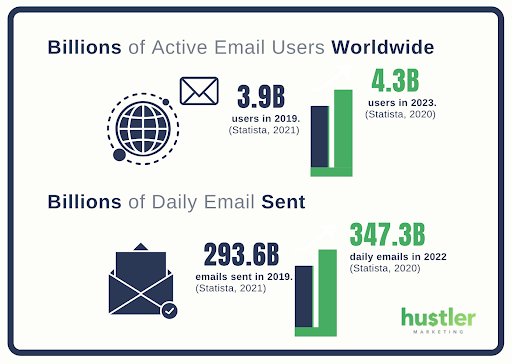Published July 06, 2023
Mastering Email Mailings: The Ultimate Guide to Effective Email Marketing

Welcome to the ultimate guide on mastering email mailings and unlocking the full potential of email marketing. In today’s digital landscape, email remains one of the most powerful and effective channels for engaging with your audience, nurturing leads, and driving conversions. In this comprehensive guide, we’ll dive into the strategies, tactics, and best practices that will help you craft compelling email campaigns and achieve remarkable results. Get ready to transform your email marketing game and take your business to new heights!
Table of Contents
1. The Power of Email Marketing
a. The Importance of Email Marketing in the Digital Age
b. Benefits of Email Marketing for Businesses
c. Why Email Mailings Are Essential for Success
2. Building an Effective Email List
a. Strategies to Grow Your Email Subscriber List
b. Opt-In Form Optimization Techniques
c. Segmentation and Personalization for Targeted Campaigns
d. Email List Maintenance and Cleaning
3. Crafting Irresistible Email Content
a. Subject Line Mastery: Grabbing Attention and Boosting Open Rates
b. Writing Engaging and Persuasive Email Mailings Copy
c. Designing Eye-Catching Email Templates
d. Incorporating Calls-to-Action (CTAs) for Conversions
e. Testing and Optimizing Email Mailings Content
4. Nurturing Leads and Building Relationships
a. Welcome Series: Making a Memorable First Impression
b. Drip Campaigns: Engaging Subscribers Over Time
c. Personalization and Segmentation for Targeted Communication
d. Automating Email Workflows for Efficiency
5. Optimizing Email Deliverability and Open Rates
a. Understanding Email Mailings Deliverability Factors
b. Strategies to Improve Inbox Placement
c. Best Practices for Increasing Open Rates
d. Dealing with Spam Filters
6. Analyzing Email Campaign Performance
a. Key Metrics to Track and Analyze
b. Using Email Analytics Tools for Insights
c. A/B Testing for Continuous Improvement
d. Extracting Actionable Insights from Data

What are the 4 types of marketing emails?
There are four primary types of marketing emails that businesses commonly use to engage their audience and drive conversions:
1.Promotional Emails: These email mailings focus on promoting specific products, services, or offers to generate sales or conversions. They typically include compelling offers, discounts, or incentives to encourage recipients to take action.
2. Newsletter Emails: Newsletter email mailings provide valuable information, updates, and content to subscribers on a regular basis. They often include curated content, industry news, tips, and educational resources to keep subscribers informed and engaged.
3. Welcome Emails: Welcome email mailings are sent to new subscribers to introduce them to your brand, set expectations, and deliver a warm greeting. They are an opportunity to make a positive first impression and establish a connection with your audience.
4. Transactional Emails: These emails are triggered by specific user actions, such as purchase confirmations, shipping notifications, or password resets. While primarily functional in nature, transactional emails can still be used to reinforce your brand and provide additional value to the recipient.
How do I get a free email list?
Building a free email list requires a strategic approach and a focus on organic methods. Here are some steps to get started:
1. Create Compelling Opt-In Incentives: Offer valuable content, resources, or exclusive offers to entice visitors to subscribe to your email list.
2. Optimize Website Sign-Up Forms: Place sign-up forms prominently on your website, making them easy to find and complete. Keep the form fields minimal to reduce barriers to entry.
3. Leverage Social Media: Promote your email mailings list on social media platforms to reach a wider audience. Encourage followers to join your list and share the sign-up link with their networks.
4. Guest Blogging and Content Collaboration: Write guest blog posts for relevant websites and include a link to your sign-up form within the content or author bio. Collaborate with other content creators or influencers to expand your reach and attract new subscribers.
5. Offer Exclusive Content or Webinars: Host webinars or provide gated content that requires email registration. This creates an opportunity to capture email addresses from interested participants.
Remember, building an engaged and quality email mailings list takes time and effort. Avoid purchasing email lists or using unethical practices, as these can harm your reputation and lead to low engagement rates.
What is a mailing list in email?
In email marketing, a mailing list refers to a collection of email addresses that have been gathered or subscribed to receive emails from a particular sender or organization. It serves as a database of contacts who have expressed interest in receiving communications, updates, promotions, or other content from the sender.
Mailing lists can be segmented based on various criteria, such as demographics, interests, or past interactions. Segmentation allows for more targeted and personalized email campaigns, ensuring that recipients receive content that is relevant to their needs and preferences.
What do you call a group of emails?
A group of emails can be referred to as an email list, subscriber list, or contact list. It is a collection of individual email addresses that belong to recipients who have opted in to receive emails from a particular sender or organization. The group may be categorized based on different criteria, such as subscribers’ interests, geographic location, or engagement history, to enable targeted and effective email marketing campaigns.

The Power of Email Marketing
a. The Importance of Email Marketing in the Digital Age
b. Benefits of Email Marketing for Businesses
c. Why Email Mailings Are Essential for Success
In this section, we explore the significance of email marketing in the digital age. We discuss how email remains a vital communication tool and its effectiveness in engaging with the target audience. Additionally, we highlight the benefits that businesses can gain from implementing email marketing campaigns.
“Discover the power of email marketing and how it can fuel your business growth in the digital age.”
The Power of Email Marketing
a. The Importance of Email Marketing in the Digital Age:
In today’s digital age, email marketing holds immense importance as a direct and personalized communication channel with your audience. With billions of active email users worldwide, it provides a highly effective way to reach and engage with your target market. Unlike other digital platforms that rely on algorithms or paid advertising, email allows you to have complete control over your message and directly connect with your subscribers. It enables you to nurture relationships, build trust, and deliver valuable content right to your audience’s inbox.
b. Benefits of Email Marketing for Businesses:
Email marketing offers a wide range of benefits for businesses of all sizes. First and foremost, it is a cost-effective marketing channel, requiring minimal investment compared to traditional advertising methods. It allows you to reach a large audience instantly, ensuring your message is delivered to those who have expressed interest in your brand. Email marketing also provides high conversion rates, as you can tailor your messages to specific segments of your audience, increasing the chances of engagement and conversions. Furthermore, email campaigns can be automated, saving time and effort while maintaining consistent communication with your subscribers.
c. Why Email Mailings Are Essential for Success:
Email mailings play a vital role in the success of your overall email marketing strategy. By regularly sending targeted and engaging content to your subscribers, you can build and strengthen relationships, establish brand loyalty, and drive conversions. Email mailings allow you to share valuable information, such as industry updates, product launches, promotional offers, or educational content. They provide an opportunity to showcase your expertise, reinforce your brand message, and stay top of mind with your audience. Through well-crafted email mailings, you can foster engagement, encourage repeat visits to your website, and generate a steady stream of qualified leads.
“Discover the power of email marketing as a direct and personalized communication channel, offering cost-effective marketing, high conversion rates, and the ability to nurture relationships. Learn why email mailings are essential for success, allowing you to deliver targeted content, build brand loyalty, and generate qualified leads.”

Building an Effective Email List
a. Strategies to Grow Your Email Subscriber List
b. Opt-In Form Optimization Techniques
c. Segmentation and Personalization for Targeted Campaigns
d. Email List Maintenance and Cleaning
In this section, we delve into the strategies for building a high-quality and engaged email mailings subscriber list. We discuss various techniques such as creating compelling lead magnets, optimizing opt-in forms for maximum conversions, and leveraging segmentation and personalization to deliver
targeted email campaigns. Additionally, we provide insights on maintaining and cleaning your email list to ensure deliverability and engagement.
“Learn proven strategies to build an email list that drives conversions and nurtures valuable relationships with your audience.”
Building an Effective Email List
a. Strategies to Grow Your Email Subscriber List:
To grow your email mailings subscriber list, employ effective strategies that encourage website visitors, social media followers, and customers to opt in. Offer valuable incentives such as exclusive content, discounts, or free resources in exchange for email sign-ups. Implement prominent and strategically placed sign-up forms on your website, blog, and social media platforms. Leverage partnerships, guest blogging, and collaborations to reach new audiences and attract subscribers. Additionally, utilize offline opportunities like events or trade shows to capture email addresses.
b. Opt-In Form Optimization Techniques:
Optimize your opt-in forms to maximize conversions. Keep forms short and straightforward, asking for minimal information to reduce friction. Craft compelling and concise copy that clearly communicates the benefits of subscribing. Utilize eye-catching design elements, such as color contrast and visuals, to draw attention to the form. Implement responsive forms that adapt to different devices for a seamless user experience. Test different form placements, including pop-ups, slide-ins, or embedded forms, to find the most effective placement for your audience.
c. Segmentation and Personalization for Targeted Campaigns:
Segmenting your email mailings list based on specific criteria allows you to deliver targeted and personalized campaigns. Divide your subscribers into groups based on demographics, interests, or past interactions. Tailor your email content to address the unique needs and preferences of each segment. Personalize your emails with recipient names, dynamic content, or product recommendations based on their previous interactions. By delivering relevant content to specific segments, you can significantly improve engagement, open rates, and conversions.
d. Email List Maintenance and Cleaning:
Regularly maintain and clean your email mailings list to ensure its quality and effectiveness. Remove inactive or disengaged subscribers who haven’t interacted with your emails for a certain period. Implement a re-engagement campaign to win back potentially interested subscribers before considering their removal. Keep your list updated by promptly handling unsubscribes and managing bounce rates. Regularly validate email addresses to minimize bounce rates and maintain a good sender reputation. Periodically review and refine your email list management practices to ensure optimal deliverability and engagement.
“Learn effective strategies to grow your email subscriber list through valuable incentives, optimized opt-in forms, and targeted promotion. Discover the power of segmentation and personalization for highly engaging campaigns. Ensure list quality with regular maintenance, cleaning, and optimization practices.”
Crafting Irresistible Email Content
a. Subject Line Mastery: Grabbing Attention and Boosting Open Rates
b. Writing Engaging and Persuasive Email Copy
c. Designing Eye-Catching Email Templates
d. Incorporating Calls-to-Action (CTAs) for Conversions
e. Testing and Optimizing Email Content
In this section, we focus on creating compelling email content that captivates your subscribers. We provide insights on crafting attention-grabbing subject lines, writing persuasive and engaging email copy, and designing visually appealing email templates. We also discuss the importance of incorporating clear and compelling calls-to-action (CTAs) to drive conversions. Additionally, we explore the importance of testing and optimizing email content to maximize engagement and results.
“Master the art of crafting irresistible email content that drives opens, clicks, and conversions with our proven strategies.”
Crafting Irresistible Email Content
a. Subject Line Mastery: Grabbing Attention and Boosting Open Rates:
Mastering the art of writing compelling subject lines is crucial for grabbing your subscribers’ attention and boosting open rates. Craft subject lines that are concise, intriguing, and relevant to your audience. Use personalization, urgency, curiosity, or offers to pique their interest. Test different subject lines to identify what resonates best with your audience and monitor open rates to optimize your approach.
b. Writing Engaging and Persuasive Email Copy:
When writing email copy, focus on engaging your subscribers and persuading them to take action. Use a conversational and friendly tone that resonates with your audience. Clearly communicate the value and benefits of your message or offer. Structure your email with short paragraphs, subheadings, and bullet points for easy readability. Incorporate storytelling, testimonials, or social proof to create an emotional connection. Keep the content concise and avoid overwhelming your readers with excessive information.
c. Designing Eye-Catching Email Templates:
Design visually appealing email templates that reflect your brand identity and capture attention. Use a clean and professional layout with a balanced combination of text and visuals. Incorporate your brand colors, logos, and fonts for consistency. Ensure that the email is mobile-responsive and displays correctly across different devices and email clients. Include compelling visuals, such as relevant images or graphics, to enhance engagement and support your message.
d. Incorporating Calls-to-Action (CTAs) for Conversions:
Every email should have a clear and compelling call-to-action (CTA) that prompts your subscribers to take the desired action. Use action-oriented and persuasive language for your CTAs. Make them visually prominent and easily clickable with appropriate button design and placement. Provide a sense of urgency or exclusivity to encourage immediate action. Ensure that your landing pages or destination URLs align with the CTA and deliver a seamless user experience.
e. Testing and Optimizing Email Content:
Continuously test and optimize your email mailings content to improve engagement and conversions. Conduct A/B testing to compare different variations of subject lines, email copy, CTAs, or visual elements. Monitor key metrics such as open rates, click-through rates, and conversions to evaluate the effectiveness of your tests. Analyze the data and apply the insights to refine your future email campaigns. Experiment with different content formats, personalization techniques, or segmentation strategies to discover what resonates best with your audience.
“Learn the art of crafting irresistible email content that captivates your subscribers. Master subject line techniques to boost open rates, create engaging and persuasive email copy, design eye-catching templates, incorporate effective CTAs, and continuously test and optimize your content for maximum impact.”

Nurturing Leads and Building Relationships
a. Welcome Series: Making a Memorable First Impression
b. Drip Campaigns: Engaging Subscribers Over Time
c. Personalization and Segmentation for Targeted Communication
d. Automating Email Workflows for Efficiency
In this section, we dive into the techniques for nurturing leads and building strong relationships with your subscribers. We explore the power of welcome series emails in making a memorable first impression and setting the stage for ongoing engagement. We also discuss the effectiveness of drip campaigns in delivering timely and relevant content to subscribers. Additionally, we highlight the importance of personalization, segmentation, and workflow automation for targeted and efficient communication.
“Discover how to nurture leads and build lasting relationships with your subscribers using effective email workflows and personalization strategies.”
Nurturing Leads and Building Relationships
a. Welcome Series: Making a Memorable First Impression:
A well-crafted welcome series is essential for making a memorable first impression on your subscribers. This series of automated emails introduces new subscribers to your brand, establishes trust, and sets the stage for ongoing engagement. Use the welcome series to deliver a warm greeting, share valuable resources or content, and highlight the benefits of being part of your community. Personalize the emails with the subscriber’s name and tailor the content based on their interests or preferences. The welcome series serves as a crucial touchpoint in building a strong foundation for a lasting relationship.
b. Drip Campaigns: Engaging Subscribers Over Time:
Drip campaigns are a powerful tool for engaging subscribers over time. These automated email mailings sequences deliver a series of relevant and timely content to nurture leads and guide them through the customer journey. Design a well-planned drip campaign that delivers value, educates, and encourages further interaction. Segment your audience based on their interests, behaviors, or purchase history to ensure the content is personalized and relevant. Use drip campaigns to deliver exclusive content, product recommendations, educational resources, or limited-time offers. By delivering targeted and valuable content consistently, you can foster engagement and build a relationship with your subscribers.
Personalization and segmentation are key strategies for effective communication with your subscribers. Use the information you have about your subscribers to personalize the content and make it more relevant to their needs and preferences. Segment your email list based on demographics, past interactions, or purchase behavior to send targeted messages. Tailor the content to each segment, addressing their specific pain points or interests. By delivering personalized and targeted emails, you can increase engagement, open rates, and conversions, building stronger relationships with your subscribers.
d. Automating Email Workflows for Efficiency:
Automating email workflows streamlines your communication process and ensures timely and consistent messaging. Set up automated triggers based on specific actions or events, such as sign-ups, purchases, or abandoned carts. Automate the delivery of welcome emails, onboarding sequences, or post-purchase follow-ups. By automating workflows, you save time and effort while providing a seamless experience for your subscribers. Monitor and optimize your workflows to ensure they are delivering the desired results and adjust them based on performance metrics and subscriber feedback.
“Discover how to nurture leads and build lasting relationships with your subscribers using effective email workflows, personalized content, and strategic automation. Create a memorable first impression with a well-crafted welcome series, engage subscribers over time with targeted drip campaigns, and leverage personalization and segmentation for tailored communication. Streamline your processes with automation to save time and provide a seamless experience.”
Optimizing Email Deliverability and Open Rates
a. Understanding Email Deliverability Factors
b. Strategies to Improve Inbox Placement
c. Best Practices for Increasing Open Rates
d. Dealing with Spam Filters
In this section, we address the crucial aspect of email deliverability and open rates. We provide insights on understanding the factors that affect email deliverability, including sender reputation, authentication protocols, and content quality. We also discuss strategies to improve inbox placement and increase open rates, such as maintaining a clean email list, optimizing subject lines, and following best practices. Additionally, we provide guidance on dealing with spam filters.
“Maximize email deliverability and boost open rates with our expert tips and strategies to ensure your emails reach the inbox and engage your audience.”
Optimizing Email Deliverability and Open Rates
a. Understanding Email Deliverability Factors:
To optimize email deliverability, it’s crucial to understand the key factors that affect whether your emails reach the recipients’ inboxes. These factors include sender reputation, authentication protocols (such as SPF, DKIM, and DMARC), content quality, engagement metrics, and spam complaints. By monitoring and improving these factors, you can enhance your email deliverability and ensure that your messages land in the intended recipients’ inboxes.
b. Strategies to Improve Inbox Placement:
Improve your inbox placement rates by implementing effective strategies. Maintain a positive sender reputation by consistently sending relevant and engaging content, avoiding spam traps, and promptly handling unsubscribes. Authenticate your emails using SPF, DKIM, and DMARC to verify your identity and build trust with mailbox providers. Regularly monitor your deliverability metrics, such as bounce rates and spam complaints, and take corrective actions to resolve any issues. Segment your email list and personalize your content to increase engagement and inbox placement.
c. Best Practices for Increasing Open Rates:
Increasing open rates is crucial for the success of your email mailings marketing campaigns. Craft compelling subject lines that grab attention, spark curiosity, and accurately reflect the content of your emails. Personalize subject lines and sender names to create a sense of familiarity and relevance. Test different subject line variations to identify the most effective approach. Optimize the pre-header text to provide additional context and entice recipients to open the email. Additionally, ensure that your emails are mobile-friendly and properly rendered across different devices and email clients.
d. Dealing with Spam Filters:
Spam filters are designed to protect recipients from unsolicited or malicious emails. To avoid being marked as spam, follow best practices such as avoiding spam trigger words, limiting the use of excessive punctuation or capitalization, and balancing text-to-image ratios. Regularly monitor your spam complaint rates and promptly address any issues. Stay updated on the latest spam filter algorithms and adjust your email content and practices accordingly. Monitor your sender reputation and promptly address any blocking issues to maintain a good sender reputation.
“Optimize your email deliverability and increase open rates with our expert strategies. Understand the factors that affect email deliverability, implement strategies to improve inbox placement, employ best practices for increasing open rates, and navigate spam filters to avoid blocking. Enhance your email marketing success by ensuring your emails reach the inbox and captivate your audience.”
Analyzing Email Campaign Performance
a. Key Metrics to Track and Analyze
b. Using Email Analytics Tools for Insights
c. A/B Testing for Continuous Improvement
d. Extracting Actionable Insights from Data
In this section, we explore the importance of analyzing email campaign performance to gain insights and drive continuous improvement. We discuss key metrics to track and analyze, such as open rates, click-through rates, conversion rates, and ROI. We also highlight the use of email analytics tools to gather data and extract valuable insights. Additionally, we cover the significance of A/B testing to optimize email campaigns and make data-driven decisions.
“Unlock the power of data-driven decision-making by analyzing email campaign performance and leveraging actionable insights for ongoing success.”
Analyzing Email Campaign Performance
a. Key Metrics to Track and Analyze:
When analyzing email mailings campaign performance, it’s essential to track and analyze key metrics that provide insights into the effectiveness of your campaigns. These metrics include open rates, click-through rates (CTRs), conversion rates, bounce rates, unsubscribe rates, and overall engagement. By monitoring these metrics, you can gauge the success of your campaigns, identify areas for improvement, and make data-driven decisions to optimize your email marketing strategy.
b. Using Email Analytics Tools for Insights:
Email analytics tools offer valuable insights into your campaign performance. Utilize tools like Google Analytics, email service provider analytics, or dedicated email marketing platforms to track and analyze metrics in detail. These tools provide data on open rates, CTRs, subscriber behavior, device usage, and more. Leverage the insights from these tools to understand subscriber preferences, identify trends, and measure the impact of your email campaigns. Use these insights to refine your targeting, content, and overall email marketing strategy.
c. A/B Testing for Continuous Improvement:
A/B testing is a valuable technique for continuous improvement of your email campaigns. Test different variations of subject lines, email copy, visuals, CTAs, or sending times to identify what resonates best with your audience. Split your subscriber list into segments and send different versions of your email to each segment. Analyze the results to determine which variation performs better and use those insights to optimize future campaigns. A/B testing helps you refine your email content, increase engagement, and drive better results.
d. Extracting Actionable Insights from Data:
To extract actionable insights from your email mailings campaign data, it’s important to dive deeper into the metrics and identify patterns and trends. Look for correlations between specific content or design elements and higher engagement or conversions. Analyze the behavior of different segments of your audience to understand their preferences and tailor your messaging accordingly. Regularly review your campaign data to identify opportunities for improvement, such as optimizing subject lines, content, or targeting strategies.
“Unlock the power of data-driven decision-making by analyzing your email campaign performance. Track and analyze key metrics, utilize email analytics tools for valuable insights, conduct A/B testing for continuous improvement, and extract actionable insights from your data. Maximize the effectiveness of your email marketing strategy through data-driven optimization.”

Ready to take your email marketing to the next level?
Contact us today to unlock the full potential of your campaigns and drive engagement, conversions, and customer loyalty. Let’s create impactful email experiences together!
Comments
[op3_comments_render][/op3_comments_render]
Copyright © 2024 SEO Website Masters. All Rights Reserved


